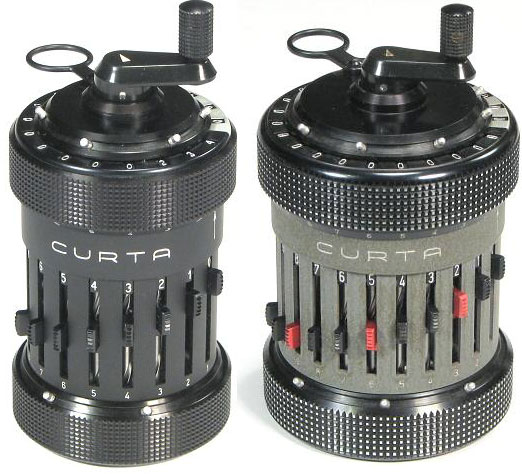Curta Mechanical Calculator Introduction
I bought a Curta mechanical calculator as a gift for my grandfather who has wanted one for a while, and I can’t wait to see the look on his face. However, I have some months before the next time I’ll get out to see him, so I want to do some stuff with it first.
- Learn how to use it
- Provide printed instructions for my grandfather
Curta Calculators

Model 1 (left) and model 2 (right) [Retrieved from history-computer.com ]
The first and most glaring problem is that I received the Curta without an instruction manual. Just a dinky little ad pamphlet. So that prompted me to look online for an instruction manual, preferably in the public domain. After all, my grandfather doesn’t want it because he collects these things, he wants to hold a part of history and actually use the thing. Well imagine my surprise when all the online resources for the Curta tend toward information that collectors might care about. Which models exist, variations in manufacturing, serial numbers, history, distribution, etc. I found three online resources but I had to dig.
The vcalc.net article seems to have the same content as the curta.org wiki, but it includes some rudimentary formatting and images. I take it this is a transcribed version of the original operating manual. Ideally, I’d like to find a paper copy of one on ebay or something, but while the calculators themselves are plentiful, the manuals don’t seem to exist.
And so, I’d like to see if I can’t improve on the presentation somewhat and give that to my grandfather with the calculator. My biggest beef with the operator’s manual (if that is in fact what vcalc and curta.org are printing digitally) is that it reads more like a tutorial than a reference. It guides the user through some exercises for different operations, and that’s a decent approach. It seems like the exercises aren’t arranged by topic or difficulty though. It also seems like there’s a lot of repetition. Right at the beginning, there’s one about one-handed operation. Is one-handed operation more important than knowing how to actually add or multiply numbers?
The topics I’d like to explore are:
- High-level diagrams
- Representing numbers
- Positive and negative
- Decimals
- Arithmetic operations
- Addition
- Subtraction
- Multiplication
- Division
- Advanced operations
- Logarithms and exponents
- Trig?
- Memory
- Intermediate calculations and storage
- Undo/rollback
I know most of these are possible, but for some of them I can only guess. For instance, I found an article about the popularity of these devices for a certain category of rally racing that requires everything be analog. There was an offhand comment in that article that it was possible to revert the last operation made, but no details on how. I haven’t found it in any operator guides either, but perhaps I didn’t look hard enough. Trig operations may not be possible but I’d like to explore the possibility.
I suppose I’d also like to include some material about the history of the Curta and its founder. Not from a collector’s perspective, but from a historian’s. I don’t find much value in dates of manufacture, production volume, variations in manufacturing, rarity, pricing, and so on. I would like to know more about things like,
- Curt Herzstark, the inventor
- Concept and invention
- Notable uses
- Internal mechanical diagrams
Much of this information, especially relating to Curt himself, is available online and I’ll probably just print out some websites and put that in a binder. I’ll also be looking for print resources to cite.
